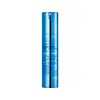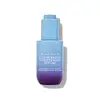What's inside
What's inside
 Key Ingredients
Key Ingredients

 Benefits
Benefits

 Concerns
Concerns

No concerns
 Ingredients Side-by-side
Ingredients Side-by-side

Water
Skin ConditioningGlycerin
HumectantButylene Glycol
HumectantDipropylene Glycol
HumectantNiacinamide
SmoothingGlycereth-26
Humectant1,2-Hexanediol
Skin ConditioningHydroxyethyl Urea
HumectantPanthenol
Skin ConditioningTrehalose
HumectantBetaine
HumectantCarbomer
Emulsion StabilisingAllantoin
Skin ConditioningC12-14 Alketh-12
EmulsifyingEthylhexylglycerin
Skin ConditioningCaprylyl Glycol
EmollientTromethamine
BufferingXanthan Gum
EmulsifyingHydroxyacetophenone
AntioxidantAdenosine
Skin ConditioningGlyceryl Acrylate/Acrylic Acid Copolymer
HumectantDisodium EDTA
Silica
AbrasiveMelia Azadirachta Leaf Extract
Skin ConditioningGlyceryl Glucoside
HumectantPvm/Ma Copolymer
Emulsion StabilisingMelia Azadirachta Flower Extract
Skin ConditioningSodium Hyaluronate
HumectantPhenyl Trimethicone
Skin ConditioningCoccinia Indica Fruit Extract
Skin ConditioningPolyglyceryl-10 Laurate
Skin ConditioningPolyglyceryl-10 Myristate
Skin ConditioningHydrolyzed Sodium Hyaluronate
Skin ConditioningHydrogenated Lecithin
EmulsifyingSolanum Melongena Fruit Extract
Skin ConditioningEctoin
Skin ConditioningOcimum Sanctum Leaf Extract
Skin ConditioningCentella Asiatica Extract
CleansingCorallina Officinalis Extract
Skin ConditioningCurcuma Longa Root Extract
MaskingGlucose
HumectantPropolis Extract
Skin ConditioningAsiaticoside
AntioxidantAsiatic Acid
Skin ConditioningMadecassic Acid
Skin ConditioningMadecassoside
AntioxidantDecapeptide-40
Skin ConditioningWater, Glycerin, Butylene Glycol, Dipropylene Glycol, Niacinamide, Glycereth-26, 1,2-Hexanediol, Hydroxyethyl Urea, Panthenol, Trehalose, Betaine, Carbomer, Allantoin, C12-14 Alketh-12, Ethylhexylglycerin, Caprylyl Glycol, Tromethamine, Xanthan Gum, Hydroxyacetophenone, Adenosine, Glyceryl Acrylate/Acrylic Acid Copolymer, Disodium EDTA, Silica, Melia Azadirachta Leaf Extract, Glyceryl Glucoside, Pvm/Ma Copolymer, Melia Azadirachta Flower Extract, Sodium Hyaluronate, Phenyl Trimethicone, Coccinia Indica Fruit Extract, Polyglyceryl-10 Laurate, Polyglyceryl-10 Myristate, Hydrolyzed Sodium Hyaluronate, Hydrogenated Lecithin, Solanum Melongena Fruit Extract, Ectoin, Ocimum Sanctum Leaf Extract, Centella Asiatica Extract, Corallina Officinalis Extract, Curcuma Longa Root Extract, Glucose, Propolis Extract, Asiaticoside, Asiatic Acid, Madecassic Acid, Madecassoside, Decapeptide-40
Water
Skin ConditioningGlycerin
HumectantPropanediol
SolventNiacinamide
SmoothingAcetyl Glycyl Beta-Alanine
Skin ConditioningAlpha-Arbutin
AntioxidantCentella Asiatica Leaf Extract
Skin ConditioningTetrapeptide-30
Skin ConditioningCopper Palmitoyl Heptapeptide-14
Skin ConditioningPalmitoyl Sh-Heptapeptide-12 Sp
Skin ConditioningTulipa Gesneriana Flower Extract
Skin ConditioningCrocus Chrysanthus Bulb Extract
Skin ConditioningGlycyrrhiza Glabra Root Extract
BleachingKinetin
Skin ConditioningIndole Acetic Acid
Skin ConditioningAvena Sativa Kernel Extract
AbrasiveCorallina Officinalis Extract
Skin ConditioningPanthenol
Skin ConditioningAllantoin
Skin ConditioningMelia Azadirachta Flower Extract
Skin ConditioningMelia Azadirachta Leaf Extract
Skin ConditioningCoccinia Indica Fruit Extract
Skin ConditioningCamellia Sinensis Leaf Extract
AntimicrobialSodium Hyaluronate
HumectantLactic Acid/Glycolic Acid Copolymer
Skin ConditioningBetaine
HumectantAcacia Senegal Gum
MaskingXanthan Gum
EmulsifyingPotassium Sorbate
PreservativeSodium Benzoate
MaskingMaltodextrin
AbsorbentCaprylyl Glycol
Emollient1,2-Hexanediol
Skin ConditioningPolyvinyl Alcohol
Sodium Hydroxide
BufferingCitric Acid
BufferingWater, Glycerin, Propanediol, Niacinamide, Acetyl Glycyl Beta-Alanine, Alpha-Arbutin, Centella Asiatica Leaf Extract, Tetrapeptide-30, Copper Palmitoyl Heptapeptide-14, Palmitoyl Sh-Heptapeptide-12 Sp, Tulipa Gesneriana Flower Extract, Crocus Chrysanthus Bulb Extract, Glycyrrhiza Glabra Root Extract, Kinetin, Indole Acetic Acid, Avena Sativa Kernel Extract, Corallina Officinalis Extract, Panthenol, Allantoin, Melia Azadirachta Flower Extract, Melia Azadirachta Leaf Extract, Coccinia Indica Fruit Extract, Camellia Sinensis Leaf Extract, Sodium Hyaluronate, Lactic Acid/Glycolic Acid Copolymer, Betaine, Acacia Senegal Gum, Xanthan Gum, Potassium Sorbate, Sodium Benzoate, Maltodextrin, Caprylyl Glycol, 1,2-Hexanediol, Polyvinyl Alcohol, Sodium Hydroxide, Citric Acid
 Reviews
Reviews

Ingredients Explained
These ingredients are found in both products.
Ingredients higher up in an ingredient list are typically present in a larger amount.
1,2-Hexanediol is a synthetic liquid and another multi-functional powerhouse.
It is a:
- Humectant, drawing moisture into the skin
- Emollient, helping to soften skin
- Solvent, dispersing and stabilizing formulas
- Preservative booster, enhancing the antimicrobial activity of other preservatives
Allantoin is a soothing ingredient known for its protective and moisturizingg properties. Because of this, it is often added to products with strong active ingredients.
Studies show higher concentrations of this ingredient can promote wound healing.
Though it can be derived from the comfrey plant, allantoin is produced synthetically for cosmetic products to ensure purity.
Learn more about AllantoinBetaine is a common humectant (a substance that promotes retention of moisture). It's known to be gentle on the skin and can help balance hydration.
This ingredient is best for improving hydration and soothing irritated skin. Studies also show it helps even out skin tone.
Fun fact: Betaine is naturally created in the skin and body. The kind found within cosmetic products can be either plant-derived or synthetic.
Another name for betaine is trimethylglycine.
Learn more about BetaineCaprylyl Glycol is a humectant and emollient, meaning it attracts and preserves moisture.
It is a common ingredient in many products, especially those designed to hydrate skin. The primary benefits are retaining moisture, skin softening, and promoting a healthy skin barrier.
Though Caprylyl Glycol is an alcohol derived from fatty acids, it is not the kind that can dry out skin.
This ingredient is also used as a preservative to extend the life of products. It has slight antimicrobial properties.
Learn more about Caprylyl GlycolCoccinia Indica Fruit Extract is also known as Ivy Gourd Fruit Extract. It has skin conditioning properties.
Corallina Officinalis Extract is from the red seaweed, Corallina Officinalis. This seaweed is found all over the world but is most common in the rocky shores of Great Britain and Ireland.
Corallina Officinalis Extract contains antioxidant and emollient properties.
Extracted polysaccharides, galactose and xylose, in red algae showed antioxidant activity. Antioxidants help with anti-aging by neutralizing free-radical molecules. Free-radical molecules may damage your skin cells and DNA. Galactose is also a PHA.
Corallina Officinalis is structurally similar to coral due to its high calcium content.
Learn more about Corallina Officinalis ExtractGlycerin is already naturally found in your skin. It helps moisturize and protect your skin.
A study from 2016 found glycerin to be more effective as a humectant than AHAs and hyaluronic acid.
As a humectant, it helps the skin stay hydrated by pulling moisture to your skin. The low molecular weight of glycerin allows it to pull moisture into the deeper layers of your skin.
Hydrated skin improves your skin barrier; Your skin barrier helps protect against irritants and bacteria.
Glycerin has also been found to have antimicrobial and antiviral properties. Due to these properties, glycerin is often used in wound and burn treatments.
In cosmetics, glycerin is usually derived from plants such as soybean or palm. However, it can also be sourced from animals, such as tallow or animal fat.
This ingredient is organic, colorless, odorless, and non-toxic.
Glycerin is the name for this ingredient in American English. British English uses Glycerol/Glycerine.
Learn more about GlycerinMelia Azadirachta Flower Extract is from the Neem tree. Neem trees originate from India.
Melia Azadirachta Flower Extract contains antioxidants. Antioxidants help fight free-radicals. Free-radicals are molecules that may damage your skin cells, such as pollution.
The flowers of this tree are lilac colored.
Learn more about Melia Azadirachta Flower ExtractMelia Azadirachta Leaf Extract is extract from the neem plant.
The leaves of this tree contain flavonoids and polyphenols. These two compounds are antioxidants, anti-inflammatory, and antibacterial. Further research is needed as to their effects when applied on skin.
Niacinamide is a multitasking form of vitamin B3 that strengthens the skin barrier, reduces pores and dark spots, regulates oil, and improves signs of aging.
And the best part? It's gentle and well-tolerated by most skin types, including sensitive and reactive skin.
You might have heard of "niacin flush", or the reddening of skin that causes itchiness. Niacinamide has not been found to cause this.
In very rare cases, some individuals may not be able to tolerate niacinamide at all or experience an allergic reaction to it.
If you are experiencing flaking, irritation, and dryness with this ingredient, be sure to double check all your products as this ingredient can be found in all categories of skincare.
When incorporating niacinamide into your routine, look out for concentration amounts. Typically, 5% niacinamide provides benefits such as fading dark spots. However, if you have sensitive skin, it is better to begin with a smaller concentration.
When you apply niacinamide to your skin, your body converts it into nicotinamide adenine dinucleotide (NAD). NAD is an essential coenzyme that is already found in your cells as "fuel" and powers countless biological processes.
In your skin, NAD helps repair cell damage, produce new healthy cells, support collagen production, strengthen the skin barrier, and fight environmental stressors (like UV and pollution).
Our natural NAD levels start to decline with age, leading to slower skin repair, visible aging, and a weaker skin barrier. By providing your skin niacinamide, you're recharging your skin's NAD levels. This leads to stronger, healthier, and younger looking skin.
Another name for vitamin B3 is nicotinamide. This vitamin is water-soluble and our bodies don't store it. We obtain Vitamin B3 from either food or skincare. Meat, fish, wheat, yeast, and leafy greens contain vitamin B3.
The type of niacinamide used in skincare is synthetically created.
Learn more about NiacinamidePanthenol is a common ingredient that helps hydrate and soothe the skin. It is found naturally in our skin and hair.
There are two forms of panthenol: D and L.
D-panthenol is also known as dexpanthenol. Most cosmetics use dexpanthenol or a mixture of D and L-panthenol.
Panthenol is famous due to its ability to go deeper into the skin's layers. Using this ingredient has numerous pros (and no cons):
Like hyaluronic acid, panthenol is a humectant. Humectants are able to bind and hold large amounts of water to keep skin hydrated.
This ingredient works well for wound healing. It works by increasing tissue in the wound and helps close open wounds.
Once oxidized, panthenol converts to pantothenic acid. Panthothenic acid is found in all living cells.
This ingredient is also referred to as pro-vitamin B5.
Learn more about PanthenolSodium Hyaluronate is hyaluronic acid's salt form. It is commonly derived from the sodium salt of hyaluronic acid.
Like hyaluronic acid, it is great at holding water and acts as a humectant. This makes it a great skin hydrating ingredient.
Sodium Hyaluronate is naturally occurring in our bodies and is mostly found in eye fluid and joints.
These are some other common types of Hyaluronic Acid:
Learn more about Sodium HyaluronateWater. It's the most common cosmetic ingredient of all. You'll usually see it at the top of ingredient lists, meaning that it makes up the largest part of the product.
So why is it so popular? Water most often acts as a solvent - this means that it helps dissolve other ingredients into the formulation.
You'll also recognize water as that liquid we all need to stay alive. If you see this, drink a glass of water. Stay hydrated!
Learn more about WaterXanthan gum is used as a stabilizer and thickener within cosmetic products. It helps give products a sticky, thick feeling - preventing them from being too runny.
On the technical side of things, xanthan gum is a polysaccharide - a combination consisting of multiple sugar molecules bonded together.
Xanthan gum is a pretty common and great ingredient. It is a natural, non-toxic, non-irritating ingredient that is also commonly used in food products.
Learn more about Xanthan Gum